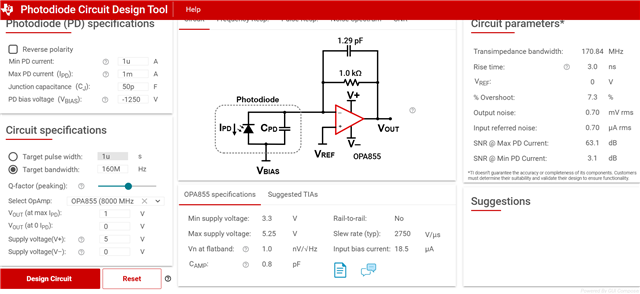Tool/software:
Help with Circuit Design for H6520 PMT – Single/Few-Photon Pulse Detection
Hello E2E Experts,
Good day.
I'm designing a pulse-counting circuit using the Hamamatsu H6520 PMT to detect single to few-photon events from a chemical reaction (triggered via chemiluminescence). The datasheet for this PMT is limited, and I would like help in designing the circuit to capture the output pulses with good timing accuracy and very less noise.
Specifications
Assembly Size Dia 23.5 mm
Built-in PMT Type No. R1166
Photocathode Area Shape Round
Photocathode Area Size Dia. 15 mm
Wavelength (Short) 300 nm
Wavelength (Long) 650 nm
Wavelength (Peak) 420 nm
Spectral Response Curve Code 400K
Photocathode Material Bialkali
Window Material Borosilicate glass
Dynode Structure Linear-focused
Dynode Stages 10
[Max. Rating] Anode to Cathode Voltage -1250 V
[Max. Rating] Average Anode Current 0.33 mA
Anode to Cathode Supply Voltage -1000 V
[Cathode] Luminous Sensitivity Typ. 110 μA/lm
[Cathode] Blue Sensitivity Index (CS 5-58) Typ. 10.5
[Anode] Luminous Sensitivity Typ. 110 A/lm
[Anode] Gain Typ. 1.0 x 106
[Anode] Dark Current (after 30min.) Typ. 1 nA
[Anode] Dark Current (after 30min.) Max. 5 nA
[Time Response] Rise Time Typ. 2.5 ns
[Time Response] Transit Time Typ. 27 ns
[Time Response] Transit Time Spread Typ. 2.8 ns
[Anode] Pulse Linearity (2% deviation) == 4 mA
[Anode] Pulse Linearity (5% deviation) 7 mA
Output Type Current pulse (terminated with 50 Ω)
PMT link: www.hamamatsu.com/.../H6520.html
Application Details:
Need to detect single to few-photon events.
PMT output: fast, small current pulses (~μA to mA).
50 Ω termination → pulse voltages in tens of mV.
Goal: high SNR + wide bandwidth to preserve pulse shape.


